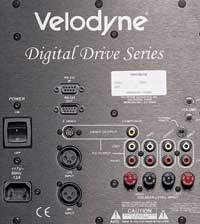Artison Portrait Home Theater Speakers Page 3
With the support of the Velodyne DD-12 sub, the Portrait LCRs were able to play surprisingly loud. In fact, the louder they played, the more dynamic they sounded. Thanks to the DD-12's digital-domain EQ and crossover controls, I was able to blend the LCRs with the sub perfectly. I won't say much more about the DD-12 - this is an Artison report, after all - except to note that it's one hell of a subwoofer. (Of course, for $3,000 it ought to be.)
 The "phantom" center speaker sounded as good as the front left/right channels, which is not surprising since the upper L/R driver arrays used to create it are identical to the lower arrays used for the L/R channels themselves. Each LCR's upper array has a three-position Presence switch marked 0, -, and +. In my setup, the + setting yielded impressively seamless tonality across the front. From my usual middle seating position, dialogue and TV announcers both sounded centered, clear, and intelligible, with ample dynamic range and punch. The spatial sweet spot was narrow, however, and when I sat on the ends of the couch, the sound's point of origin shifted noticeably toward the near-side screen edge, though slightly less than it did with a phantom-center setup using two conventional left/right speakers.
The "phantom" center speaker sounded as good as the front left/right channels, which is not surprising since the upper L/R driver arrays used to create it are identical to the lower arrays used for the L/R channels themselves. Each LCR's upper array has a three-position Presence switch marked 0, -, and +. In my setup, the + setting yielded impressively seamless tonality across the front. From my usual middle seating position, dialogue and TV announcers both sounded centered, clear, and intelligible, with ample dynamic range and punch. The spatial sweet spot was narrow, however, and when I sat on the ends of the couch, the sound's point of origin shifted noticeably toward the near-side screen edge, though slightly less than it did with a phantom-center setup using two conventional left/right speakers.
The Artison system hit its stride with movie soundtracks. I watched snippets of a dozen films, a couple of HDTV ball games and TV dramas, plus several movies in full, and everything I heard told me I was listening to a high-end surround system.
| PLUS Elegant integration with flat-panel TVs. Excellent tonal blanace, free of coloration. Wide, believable front image. MINUS Narrow spatial sweet spot for center channel. |
Narc is a terrific, highly atmospheric movie that at first glance doesn't seem to depend much on sound. Yet its close, claustrophobic interiors, occasional shocking bursts of violence, and subtle ambient effects - like the tiny, discreet echoes in the bathroom scene between Jason Patric and Krista Bridges in Chapter 19 - could easily be undermined by poor sound reproduction. But the Portrait system reliably provided a transparent, spatially natural window on the filmmakers' careful and artistic production.
Multichannel music, too, sounded very good, particularly natural-acoustic material like saxophonist James Carter's Billie Holiday tribute, Gardenias for Lady Day, on SACD. Artison's compact LRS surround speakers produced a big, enveloping ambience, but they still sounded solid on discrete instruments or voices and played loud without complaint.
In sum, Artison's Portrait system does a great job at mimicking the visual style of flat-panel TVs while aurally impersonating a suite of big, boxy home theater speakers. If looks, elegance, and a svelte layout are as important to you as sonics, I'd recommend looking at - and listening to - the Portrait system in a New York minute. Artison's powerful solution to the appearance vs. performance dilemma could be just what you're looking (and listening) for.













































